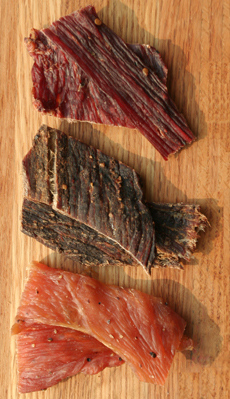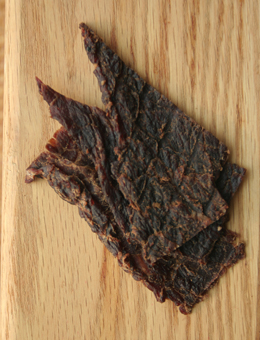 
Pecan-smoked beef, applewood-smoked beef and turkey, three types of gourmet jerky from Double B. All photography by Michael Steele.
|
KAREN HOCHMAN is Editorial Director of THE NIBBLE.
|
|
July 2007
Updated January 2009
|
 |
Gourmet Jerky
Beef, Chicken & Turkey Jerky Make Nutritious Snacks
CAPSULE REPORT: Beef Jerky isn’t just dry, tough stuff for tough guys to chew on. Top meats make top jerky, and there are new gourmet jerkys that make delicious snacks—and clever recipe ingredients, too. Preservative-free, you’d give them to your kids...if you were generous enough to give any away at all. The Jerky Guy makes beef jerky that melts in your mouth. Double B Jerky makes all natural beef and turkey jerky from antibiotic- and hormone-free meat. Silver Creek makes beef and chicken jerky in 50-calorie snack strips. This is Page 1 of a five-page article. Click on the black links below to visit other pages.
The History Of Jerky
From our early days on earth, Homo sapiens has been drying meat to preserve it: Meat drying over a smoky fire is protected from egg-laying insects and multiplying bacteria. Cutting it into thin strips makes it easier to chew. The word jerky comes from the Quechua language of the Incas, who called their dried meat “charqui.” While the prehistoric method of meat preservation was used by other ancient peoples, it was not known in Europe; the first visitors to the New World found Native Americans making jerky* from the meat of any animal they hunted (that which wasn’t consumed immediately). The pioneers quickly learned to make jerky since it was easy to transport and an important, high protein addition to their diet. The meat could be anything from buffalo to whale—and today jerky can be found in meats as common as turkey, tuna and salmon, to exotic alligator and ostrich.
*The pemmican you may have read about in tales of early America was dried meat mixed with dried berries and rendered animal fat. It was invented by Native Americans and used extensively by immigrants in the fur trade, and many years later as a high-calorie food by Arctic and Antarctic explorers such as Robert Falcon Scott and Roald Amundsen.
Today’s jerky eaters enjoy it as a snack rather than a necessity, and have the luxury of eating jerky marinated in a variety of spices, salt and/or sugar—seasonings not available to many ancients. All the fat is trimmed from the meat because fat doesn’t dry. The jerky is then dried in low-heat smokers—not hung on racks to dry in the sun as was done pre-modern day. But like ancient jerky, the modern product can be stored for long periods of time without refrigeration.
If your only experience with jerky has been dry and tasteless jerky from a convenience store, you may wonder why we’re writing about jerky. There’s wonderful jerky out there—Gary West Buffalo Strips were a Top Pick Of The Week and a gourmet product that we serve at dinner parties. And two new gourmet jerky finds are packaged in snack bags to be enjoyed more casually.
The only caveat with jerky is that it’s very high in sodium—don’t buy it for anyone on a salt-restricted diet. But it’s almost fat free, and solid protein—one ounce has about 23% of one’s daily value of protein. |

The Jerky Guy’s Black Pepper Jerky: thin, tender strips of meat that melt in your mouth. |
Continue To Page 2: The Jerky Guy
Go To The Article Index Above

|





